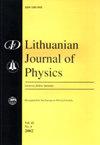(Cu–Ni–Mn–Fe)/(W–C)复合材料界面的物理化学过程
IF 0.3
4区 物理与天体物理
Q4 PHYSICS, MULTIDISCIPLINARY
引用次数: 0
摘要
使用自发渗透法制造复合材料,其中熔融的Cu–Ni–Mn–Fe粘结剂由于毛细管力渗透W–C填料颗粒。对所得金属基复合材料的相组成、微观结构、孔隙率和显微硬度进行了表征。所有复合材料都在其制备条件下进行了研究,并在900°С下进一步退火60和750小时。结果表明,基于颗粒/基体界面溶解/扩散结合的机制与本研究结果一致。界面反应提供了润湿的驱动力,但不会产生可能降低复合材料性能的不需要的相。根据EDX测量得出结论,主要是Fe原子从Cu–Ni–Mn–Fe粘结剂扩散到共晶(WC+W2C)填料的WC相中。该相的溶解导致界面处出现W2C层。在900°С下退火显著促进了界面反应,尤其是在热处理的前60小时。熔融的Cu–Ni–Mn–Fe合金和W–C颗粒之间的反应程度可以通过控制粘结剂的铁含量来限制,以获得最佳界面。本文章由计算机程序翻译,如有差异,请以英文原文为准。
Physical-and-chemical processes at the interfaces of (Cu–Ni–Mn–Fe)/ (W–C) composites
The spontaneous infiltration method for fabricating composites was used, in which molten Cu–Ni–Mn–Fe binders penetrated W–C filler particles due to capillary forces. The metal matrix composites thus obtained were characterized for phase composition, microstructure, porosity and microhardness. All composites were studied in their as-prepared condition with further annealing at 900°С for 60 and 750 h. It was shown that the mechanism based on the dissolution/diffusion bonding of the particulate/matrix interface was in agreement with the results of this study. The interfacial reactions provided a driving force for wetting but did not give rise to unwanted phases that could degrade the properties of the composite materials. From the EDX measurements it was concluded that mainly Fe atoms diffused from the Cu–Ni–Mn–Fe binders into the WC phase of the eutectic (WC+W2C) filler. Dissolution of this phase resulted in the appearance of W2C layer at the interface. Annealing at 900°С significantly promoted the interfacial reaction especially during the first 60 h of heat treatment. The degree of the reaction between the molten Cu–Ni–Mn–Fe alloys and W–C particulate could be limited by controlling the iron content of the binders to obtain an optimal interface.
求助全文
通过发布文献求助,成功后即可免费获取论文全文。
去求助
来源期刊

Lithuanian Journal of Physics
物理-物理:综合
CiteScore
0.90
自引率
16.70%
发文量
21
审稿时长
>12 weeks
期刊介绍:
The main aim of the Lithuanian Journal of Physics is to reflect the most recent advances in various fields of theoretical, experimental, and applied physics, including: mathematical and computational physics; subatomic physics; atoms and molecules; chemical physics; electrodynamics and wave processes; nonlinear and coherent optics; spectroscopy.
 求助内容:
求助内容: 应助结果提醒方式:
应助结果提醒方式:


